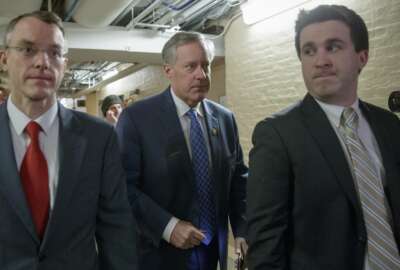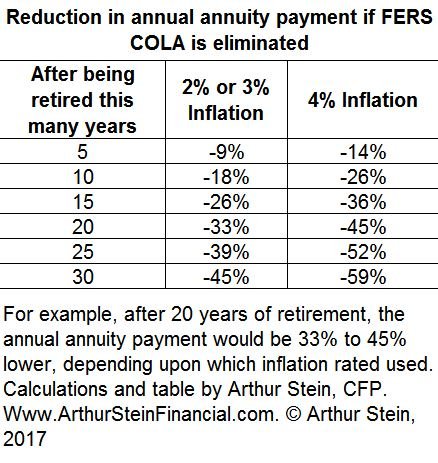

Proposed changes to the federal retirement system could force current federal employees to delay retirements and spark financial hardship for current retirees.
It’s happened before; lawmakers and think tanks have offered their own proposals to change the federal retirement system. Despite a few initial worries, current federal employees and retirees have remained relatively unscathed.
Yet that could change next year. Federal financial experts are sounding the alarm bells on the major changes to the federal retirement system included in President Donald Trump’s fiscal 2018 budget — proposals that they say would leave a significant impact on both current retirees and employees and future workers.
The full budget proposal, which the president released Tuesday, outlines $3.6 trillion in cost reductions over the next 10 years, including changes to the federal retirement system that would save the government more than $4.1 billion in 2018 and at least $149 billion over the next 10 years.
Office of Management and Budget Director Mick Mulvaney said Monday it was one of the largest areas of cost savings outlined in the president’s budget proposal. Assumed savings from the repeal and replacement of the Affordable Care Act, plus savings realized from changes to the Supplemental Nutrition Assistance Program (SNAP) and student loan programs were among the top areas of cost reductions.
Specifically, the budget calls for:
The Washington Post first reported these specific changes to the federal retirement system, which include other proposals, such as basing future retirement benefits on the average of an employee’s highest five years of salary. Currently, retirement benefits are based on an employee’s length of service, salary and highest three-year average salary.
Federal financial experts are most worried by two specific proposals: increasing employee contributions and eliminating the COLA for FERS participants.
These changes, they say, may force current employees to delay their retirements in order to put more money in the Thrift Savings Plan (TSP), and they would certainly decrease an employee’s monthly take-home pay with higher annuity contributions. Combined, these proposals have the potential to cause real hardship, said Art Stein, a financial planner and investment manager.
“It means that the purchasing power of the FERS annuity is going to decrease every year,” he said. “How much will solely depend on how high the inflation rate is. Although the inflation has been low for some time, there’s no reason to expect that to continue into the future. I really worry about people who are already retired, because retirement planning has been based upon the promises and guarantees from the federal government about their retirement annuity, and all of the sudden they’re going to see a big decrease in future benefits.”
Higher annuity contributions will make life more expensive for current employees who are still working, said Randy Silvey, president of Silverlight Financial and a Federal News Radio commentator.
On average, Silvey predicts the president’s budget proposals would force current FERS employees to pay about $2,500-$2,600 more toward their annuities a year over the first five or six years, and then $3,500 more annually after the initial phase-in period.
According to Stein’s calculations, a FERS retiree of five years would see a 9-to-14 percent reduction to his or her annual annuity payment, depending on the rate of inflation, if the Trump administration eliminated cost-of-living adjustments. Retirees would receive lower annuity payments the longer they spent away from government.

Eliminating the COLA will likely prompt FERS retirees to use their savings more quickly, as the rate of inflation increases, said Tammy Flanagan, a retirement specialist and senior benefits director for the National Institute of Transition Planning.
“For someone who has a long retirement, this is a big, big decrease in the purchasing power of their annuity,” said Stein. “It means that things like gas and food and rent and travel are going to be less and less affordable for people in the future.”
Cost-of-living adjustments have been minimal in recent years, topping 1.7 percent in 2015, 0 percent in 2016 and 0.3 percent in 2017. But it hasn’t always been that way. Federal employees received a 5.8 percent COLA back in 2009, the highest bump during the past 10 years.
“The inflation costs come back and bite a lot of retirees later in life,” said Silvey. “Not initially, not in the first five or maybe 10 years, but later after retirement, when they can’t go back to work, that’s when inflation really starts to hurt them.”
Flanagan said she feared what impact these changes would have on the young talent waiting to enter the federal workforce if current workers delay their retirements.
And Silvey wondered how agencies would recruit and retain the next generation, who have long heard their predecessors tout the federal government’s compensation package.
“Historically, people who maybe were on the fence one way or the other as to who to go work for when they got out of college, the ones who leaned toward government were because of benefits like this,” he said. “How are they going to attract them in the future? What are they going to use? That was the one big selling point that government always had; they had great benefits.”
The president’s budget proposal is merely a suggestion, and congressional appropriations committees will review and offer their own suggestions.
Many of these ideas aren’t new, but a Democrat-run White House had blocked or threatened to veto such proposals in the past. Several federal employee groups now fear the momentum is shifting in the other direction with a Republican White House and Congress, and many House Republicans last week indicated their intention to change the federal compensation and civil service system.
Yet the National Active and Retired Federal Employees Association (NARFE) predicted in March that budget negotiations for 2018 may revive familiar proposals calling for increases to current federal employees’ retirement contributions. It called the 2018 budget process “the biggest fight” that it faced this year.
“The president purports to defend government annuities like Social Security and then proposes to eliminate cost-of-living adjustments for some and limit COLAs for those already retired and living on fixed incomes,” NARFE National President Richard Thissen said of the president’s latest proposals in a May 19 statement. “It is beyond insulting. It is downright mean. Simultaneously promoting tax cuts and forcing a tax on just federal employees, through in an increase in retirement contributions, is the height of hypocrisy.”
The uncertainty has financial planners like Flanagan urging federal employees to save more than the 5 percent match the government contributes to defined benefit plans.
“Employees should expect to work until age 62 or later under a modified and greatly reduced retirement system that does not allow for future inflation adjustments,” she said.
The FERS plan provides its participants benefits from three different sources, a basic defined benefit plan, Social Security and the Thrift Savings Plan (TSP).
Under the president’s proposals, the TSP would play a much larger role in a participant’s financial future.
“These will make the TSP much, much more important,” Stein said. “Unfortunately there’s a limit in how much money people can put in the TSP, and no one can make up for the years when they didn’t contribute the full amount or didn’t allocate appropriately.”
Yet Silvey said many of the federal employees he advises don’t understand the TSP and haven’t adequately put enough savings into their accounts.
“Up until now, the federal employees have had a luxury vehicle, as far as a retirement system is concerned,” he said. “The problem is nobody every taught them how to drive.”
Copyright © 2025 Federal News Network. All rights reserved. This website is not intended for users located within the European Economic Area.
Nicole Ogrysko is a reporter for Federal News Network focusing on the federal workforce and federal pay and benefits.
Follow @nogryskoWFED

